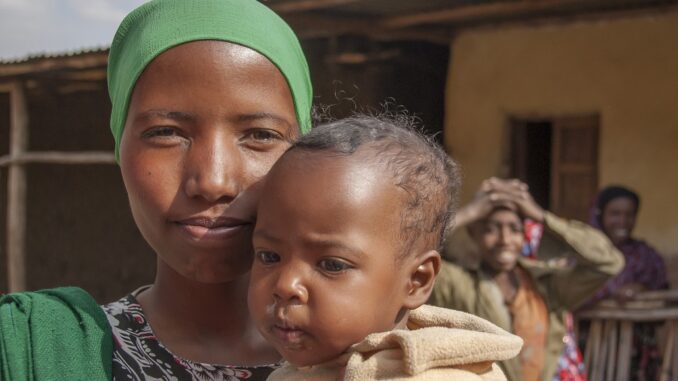
Ethiopia—as one of the most donor-dependent countries in the world—has made good progress with respect to some of the health indicators and was one of the early achievers of the health Millennium Development Goals targets. As Ethiopia continues to show great economic progress, the share of external financing will fall as the country progresses towards middle income status. Continued success in improving health outcomes into the future would therefore require a significant increase in domestic resources to fulfill the financing needs of the country’s health systems.
In a recent Duke Global Working Paper, a leading team of public finance experts discuss Ethiopia’s approach to health delivery and trends in health financing trends. With the imminent transition away from external donor support that Ethiopia faces due to economic growth, the paper explores the sources of fiscal space for health in Ethiopia to sustain progress in the health sector through a deep dive of the sources of health financing through tax and non-tax revenues, additional borrowing, future aid prospects, and better fiscal discipline and expenditure efficiency.
Intergovernmental structure of health service
While Ethiopia’s federal Ministry of Health (FMOH) has been adopting various reforms to align health sector strategies in the country with the Sustainable Development Goals (SDGs), reform efforts are complicated by the fact that Ethiopia’s health care system is fairly decentralized. In particular, there is shared decision-making where the FMOH is responsible for policy and technical support issues, while regional, district and Woreda health officials are responsible for the management and operations of the health facilities under their jurisdictions. With the exception of federal level specialized hospitals, health service delivery is largely under the authority of the regions.
Ethiopia has a three-tier healthcare delivery system. Primary health care is provided at the district or Woreda level through a primary hospital, local health centers, and rural health posts where each health center coordinates 5 satellite health posts. These health centers and posts provide basic health services related to immunization, contraception, common illnesses and hygiene. The second tier consists of a general hospital serving a population of 1 million people. PHC workers and providers refer patients to the primary hospital or general hospital depending on the severity of the illness. Finally, a specialized hospital covering a population of 5 million is the highest level (tertiary) of healthcare provision. The FMOH, Regional Bureaus of Health and districts/Woredas health office are responsible for different levels of decision making and health care delivery.
Intergovernmental financing of health services
Although public service delivery is relatively decentralized, Ethiopia is characterized as a highly-centralized federation, with a concentration of fiscal decision-making power at the center which controls most revenue raising powers. The assigned revenue sources in Ethiopia are exclusively defined in the constitution and fall under three categories: federal, concurrent and regional. The relative tax revenue balance between the federal and regional governments can be explained by the revenue assignment decisions outlined in the Constitution, which assigns the main revenue-raising sources to the federal level.
Although the majority of the tax revenue is collected by the federal government, the majority of budget expenditures are spent at the regional and sub-regional level. This difference results in a structural vertical imbalance in the allocation of revenue and resources, explaining why Ethiopia has a well-developed intergovernmental transfer system of block grants from the federal to the regional levels, and subsequently from the regional to the Woreda levels.
A review of the intergovernmental fiscal revenue sharing and intergovernmental transfers will be important to identify areas for improving the efficiency and equity of the transfer system, especially with those incentives affecting subnational revenue mobilization.
Scope for improving fiscal space for health
With global aid flat lining, Ethiopia would need to focus on identifying alternate domestic sources of fiscal space for health to maintain its health sector performance. A number of main sources of fiscal space for health exist:
Domestic revenue mobilization through structural and tax reforms. Ethiopia’s tax system has not been responsive to economic growth and Ethiopia’s tax and non-tax revenue to GDP ratio has remained relatively constant for over a decade at around 15%. Ethiopia’s tax revenue performance in Ethiopia is low relative to other low-income developing countries, and falls short of Ethiopia’s Growth and Transformation Plan targets. An improvement in Ethiopia’s tax effort from 0.48 to 0.63 in more recent years suggest that various administrative reforms have improved the country’s tax effort. To address the tax gap, structural changes through improved educational levels and coverage, urbanization, growing manufacturing and tourism sectors, coupled with tax policy and tax administration capacity improvements, and reducing inefficient tax expenditures would be necessary.
Limited scope of government borrowing. Ethiopia’s fiscal performance has been good with single digit government deficits. However, debt ratios have been increasing in Ethiopia following the end of the debt reduction under highly-indebted poor countries and the Multilateral Debt Relief Initiative. Given Ethiopia’s infrastructural needs, it is unlikely additional borrowing for the purpose of creating fiscal space , and focus should be on expanding fiscal space from other sources.
Uncertain future aid prospects. Development partners and external health financing has been key in improving Ethiopia’s health sector performance, especially through targeted primary health care interventions. However, with global development assistance for health trends suggest an uncertain aid
outlook, and domestic efforts should be focused on better aid coordination and effective use of development assistance and technical expertise to strengthen country health systems and institutions.
Improving drivers of expenditure efficiency. Ethiopia has achieved a higher level of health care expenditure efficiency compared to other comparator countries, using fewer resources to achieve greater health outcomes.
The main drivers of relatively higher efficiency in Ethiopia has been the prioritization of high impact intervention at the primary care level, task shifting, attempts to improve allocative efficiency through the One-Plan, One-Budget, One-Report system which allowed for improved integration and coordination of planning, budgeting and reporting. However, public expenditure reviews and efficiency analysis studies show that there is scope to address technical and operational inefficiencies within the health sector in Ethiopia. The government would need to focus on improving demand side inefficiencies to increase health service user demand through better information dissemination and public outreach, and reduce the barriers to access through reducing direct and indirect costs borne by the users. On the supply side, efforts need to be focused on more open and accountable budgeting, planning and coordination, procurement and human resource management, and greater discretion at the local level to respond more effectively to health care needs.
Conclusion
Ethiopia’s health sector has shown marked improvements in recent years with increased health sector
spending and improved health outcomes. However, slowdown in global donor funding and low government expenditures can threaten the progress and sustainability of health financing. Ethiopia has four major potential sources of fiscal space: development assistance; domestic revenue; borrowing; and efficiency savings. With donor funding stagnating, and taking into account, macroeconomic stability and debt sustainability concerns, the focus needs to be on domestic revenue mobilization and improvements in health expenditure efficiency.
The recently adopted health care financing strategy recognizes some of these risks and the draft strategy aims to focus on domestic resource mobilization over the next 5- 10 years. Effective health care financing in Ethiopia would require complimentary efforts to increase domestic resource mobilization effort, as well as improvements in budgeting and public financial management systems.
Read the full report:
Kelly R, Hemming R, Glenday G, Bharali I, Alebachew A. Public financial management perspectives on health sector financing and resource allocation in Ethiopia. The Center for Policy Impact in Global Health. Duke Global Working Paper Series: number 18, January 2020.





